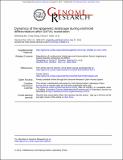Dynamics of the Epigenetic Landscape During Erythroid Differentiation after Gata1 Restoration
Author(s)
Wu, Weisheng; Cheng, Yong; Keller, Cheryl A.; Ernst, Jason; Kumar, Swathi Ashok; Mishra, Tejaswini; Morrissey, Christapher; Dorman, Christine M.; Chen, Kuan-Bei; Drautz, Daniela; Giardine, Belinda; Shibata, Yoichiro; Song, Lingyun; Pimkin, Max; Crawford, Gregory E.; Furey, Terrence S.; Kellis, Manolis; Miller, Webb; Taylor, James; Schuster, Stephan C.; Zhang, Yu; Chiaromonte, Francesca; Blobel, Gerd A.; Weiss, Mitchell J.; Hardison, Ross C.; ... Show more Show less
DownloadKellis_Dynamics of the epigenetic.pdf (2.003Mb)
PUBLISHER_CC
Publisher with Creative Commons License
Creative Commons Attribution
Terms of use
Metadata
Show full item recordAbstract
Interplays among lineage-specific nuclear proteins, chromatin modifying enzymes, and the basal transcription machinery govern cellular differentiation, but their dynamics of action and coordination with transcriptional control are not fully understood. Alterations in chromatin structure appear to establish a permissive state for gene activation at some loci, but they play an integral role in activation at other loci. To determine the predominant roles of chromatin states and factor occupancy in directing gene regulation during differentiation, we mapped chromatin accessibility, histone modifications, and nuclear factor occupancy genome-wide during mouse erythroid differentiation dependent on the master regulatory transcription factor GATA1. Notably, despite extensive changes in gene expression, the chromatin state profiles (proportions of a gene in a chromatin state dominated by activating or repressive histone modifications) and accessibility remain largely unchanged during GATA1-induced erythroid differentiation. In contrast, gene induction and repression are strongly associated with changes in patterns of transcription factor occupancy. Our results indicate that during erythroid differentiation, the broad features of chromatin states are established at the stage of lineage commitment, largely independently of GATA1. These determine permissiveness for expression, with subsequent induction or repression mediated by distinctive combinations of transcription factors
Date issued
2011-07Department
Massachusetts Institute of Technology. Computer Science and Artificial Intelligence LaboratoryJournal
Genome Research
Publisher
Cold Spring Harbor Laboratory Press
Citation
Wu, W. et al. “Dynamics of the Epigenetic Landscape During Erythroid Differentiation After GATA1 Restoration.” Genome Research 21.10 (2011): 1659–1671. Copyright © 2011 by Cold Spring Harbor Laboratory Press
Version: Final published version
ISSN
1088-9051